"Takekoma no Mori CAFÉ Ichirimanbai" at Takekoma Shrine, one of Japan's three great Inari shrines, will open on December 26th | A place to create excitement for the local community in Iwanuma City, Miyagi Prefecture
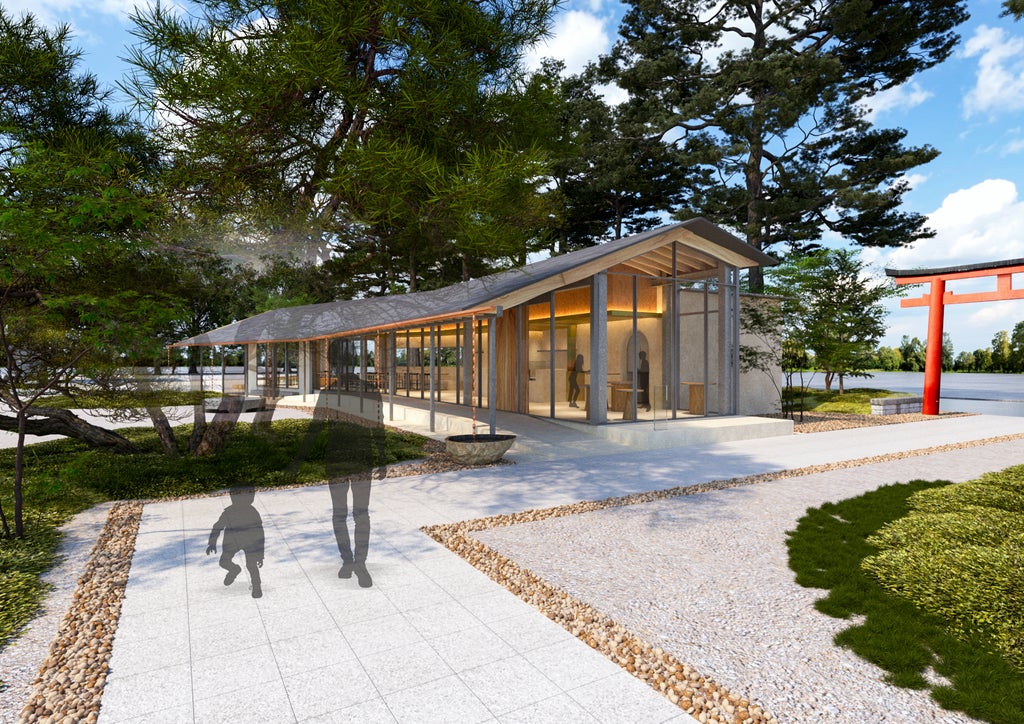
NOMURA Co.,Ltd. is responsible for the overall production of the project, including planning, product development, architecture, interiors, and landscaping concept design.
Takekoma Shrine (a religious corporation) in Iwanuma, Miyagi Prefecture, one of the three great Inari shrines in Japan, is launching a new initiative called the "Takekoma no Mori Project" to build a local community and generate more activity. As the first phase, "Takekoma no Mori CAFÉ Hitobabai," a cafe attached to a rest area within the shrine grounds, will open on December 26, 2024 (Ichibanamanbai Day).
The first phase will cover an area of approximately 1,500 square meters, and will involve creating a space where everyone can feel at ease at "Takekoma no Mori CAFÉ Hitobori Manbai," and creating a rich seasonal landscape for "Takekoma no Mori," born from the development of the shrine forest. Future plans call for the opening of an event plaza in the second phase, with plans to create a community by establishing events that connect with the local area, such as seasonal shrine events and projects involving local residents. Social media aimed at younger generations and promotions targeting inbound tourism will also be developed. NOMURA Co.,Ltd., Ltd. is responsible for the overall production, including planning, support for the opening of the cafe within the rest area, menu and product development, and architectural, interiors, and landscaping concept design.
Takekoma Shrine was faced with challenges triggered by the spread of COVID-19, including a weakening of the local community, an aging worshipper population, and a decrease in the frequency of visits. NOMURA Co.,Ltd. was involved from the planning stage, and for two and a half years worked with shrine officials to reconsider the significance of Takekoma Shrine's existence and consider new ideas for community collaboration and marketing. Going forward, the shrine will gradually implement an activity plan that utilizes the entire shrine grounds, with the aim of making Takekoma Shrine an essential part of the lives and lifestyles of local residents, and continuing to weave its more than 1,180-year history in a sustainable manner.
NOMURA Co.,Ltd. will work in collaboration with shrines and local businesses to use creativity to solve local issues and propose to society the future of shrines through this project.
Overall layout of the Takekoma Shrine grounds and the Takekoma Forest Project
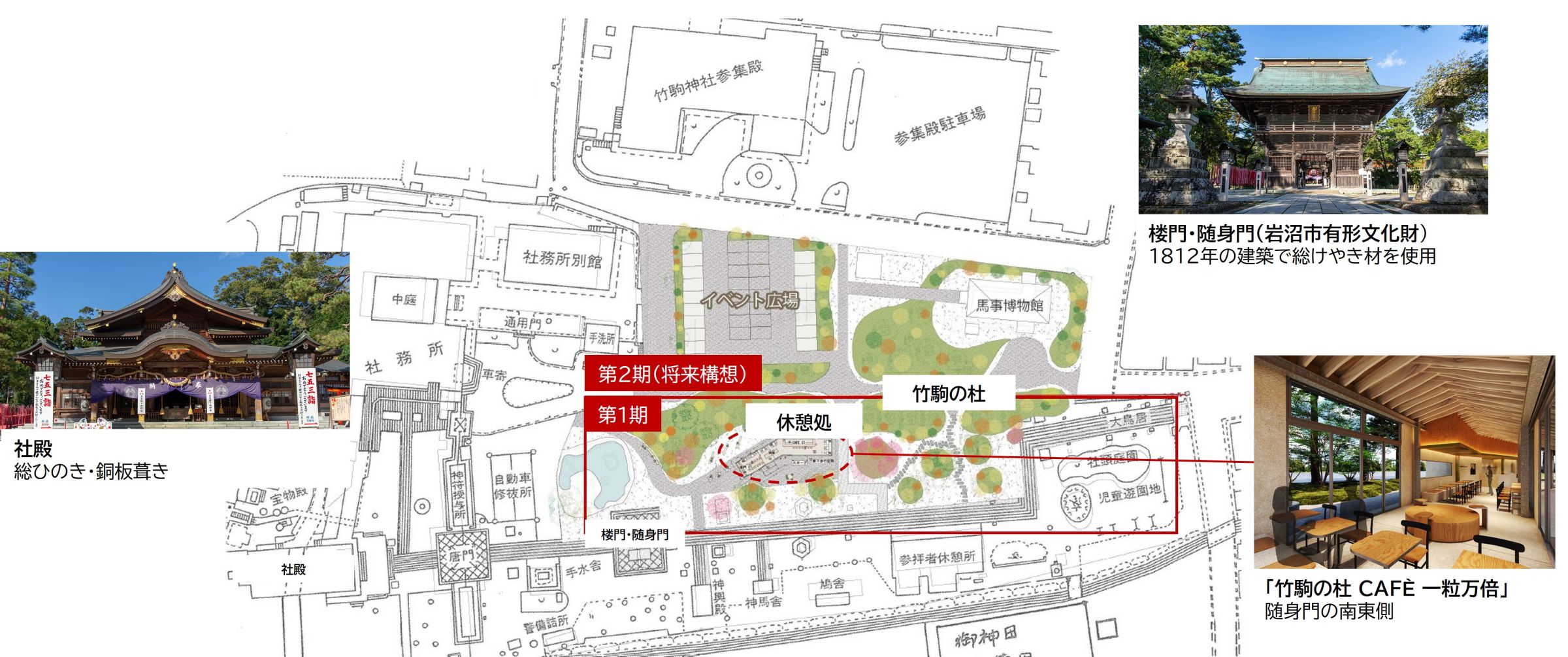
"Takekoma no Mori CAFÉ Hitotsubu Manbai" Partner companies and their roles

Overview of the preview event for "Takekoma no Mori CAFÉ Hitotsubu Manbai"
Date and time: Thursday, December 26, 2024 *Hitotsubumanbai Day 9:30am (Registration opens at 9am)
Location: The grounds of Takekoma Shrine, one of the three Inari shrines in Japan "Takekoma Forest CAFÉ Ichiri Manbai" (1-1 Inaricho, Iwanuma City, Miyagi Prefecture)
Ceremony
■Opening Ceremony: 9:30-10:30 (60 minutes)
・Greetings from the Chief Priest
・Greetings from the President of Tregion
・Explanation of the Takekoma no Mori Project and the thoughts behind "Takekoma no Mori CAFÉ Ichiribu Manbai"
・ Ribbon cutting ceremony
・Gagaku performance (shrine maiden dance)
■Mass media briefing: 10:30-11:30 (60 minutes)
・Tour and tasting session
Q&A session
Speakers:
Takekoma Shrine, one of Japan's three great Inari shrines, Chief Priest Murata
"Takekoma no Mori CAFÉ Hitobori Manbai" Management Tregion Representative Yoshida Kei / General Producer NOMURA Co.,Ltd. Sakatsume Kenichi / Creative Director NOMURA Co.,Ltd. Shirodo Kensaku
For inquiries regarding the preview, please contact: Religious Corporation Takekoma Shrine, Shintaro Muraoka and Kiho Hirazawa (0223-22-2101)
About rest areas
Considering the current issues and local needs, we thought that the existence of a community and a cafe would be an opportunity to encourage people to visit the shrine. Takekoma Shrine is home to three deities associated with business prosperity, bountiful harvests, and matchmaking. In keeping with this, we planned to create a lively atmosphere, food and drink experiences, and community collaboration through products and events. An auspicious rest area with a cafe attached was born, an experience that can only be found at Takekoma Shrine.
The rest area is being produced comprehensively NOMURA Co.,Ltd., which was also responsible for the space production of EDOCCO, the Kanda Myojin Cultural Exchange Center in Tokyo, while the menu was developed by nacrée, a Michelin one-star restaurant representing Sendai, and the area is being managed by Tregion, a company that operates food, beverage, event and coffee businesses mainly in the Tohoku region.

About Brand concept design
About the name
We named the cafe "Takekoma no Mori CAFÉ Hitobori Manbai" after the god of rice cultivation and bountiful harvests, who is the deity enshrined at Takekoma Shrine, and we hope that by developing the shrine forest and enriching the approach to the shrine, people will be able to feel the changing seasons. In addition to bringing good luck, we hope that the good deeds of each individual will revitalize the local area and become a force for building a bright future. We sincerely hope that this rest area will not only be a place of healing, but also become a part of the local community.
About the logo concept design
The name combines the character of Takekoma Shrine, where the god of bountiful harvests is enshrined, with the letter "C," which represents the building's main functions and roles: "Community," "Café," and "Celebration," to express its role as the core of the community and a new base for communication.
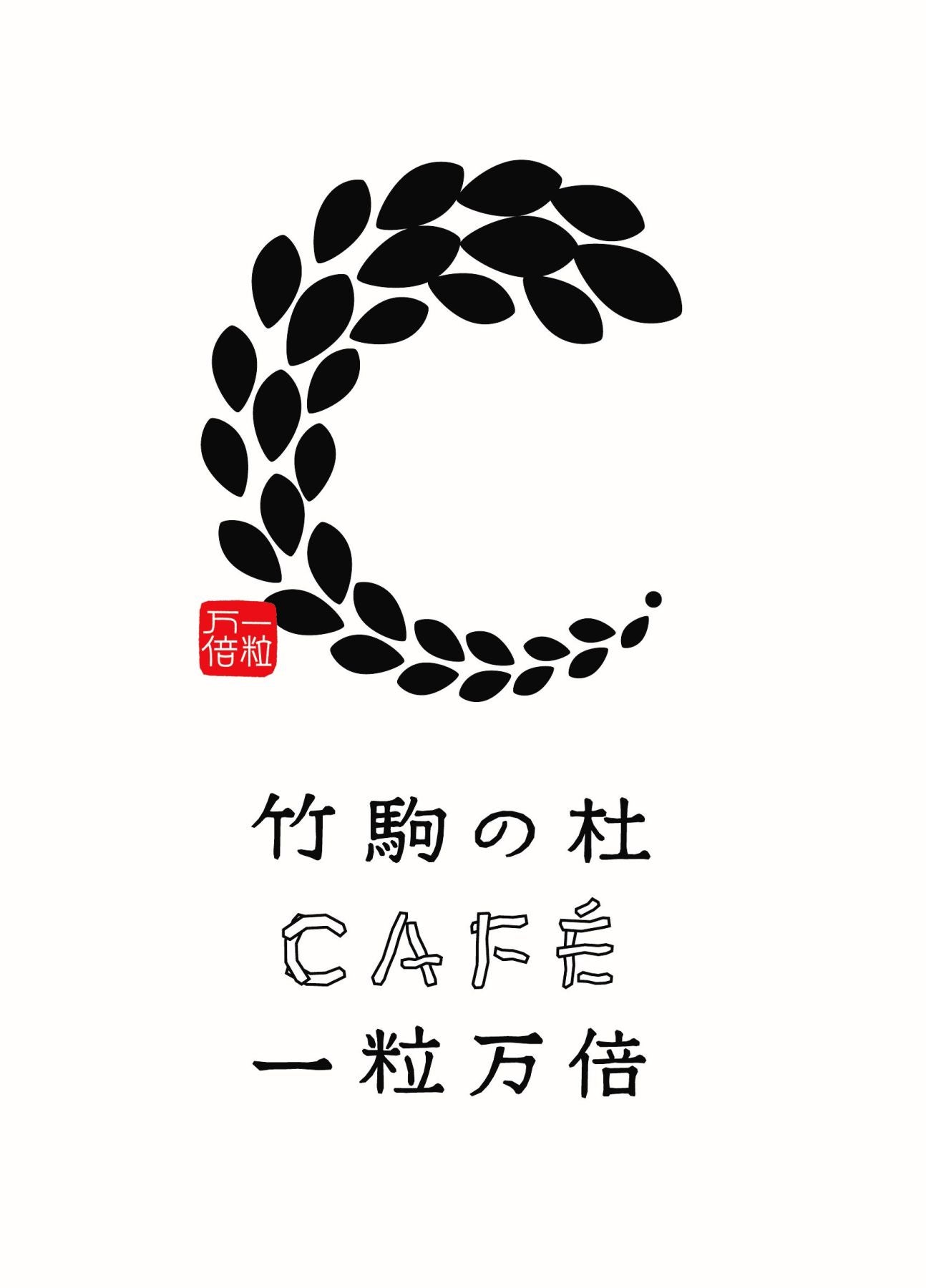
About the Takekoma Project
Project starts in spring 2022
To mark the 1180th anniversary of the shrine's founding, the "Takekoma Project" was launched as a commemorative project to reconsider the significance of Takekoma Shrine's existence and bring about new ideas for revitalizing the local area. NOMURA Co.,Ltd., Ltd., which has a proven track record in shrine revitalization, joined the project, and a project team that united the shrine, the local community, and businesses worked on the project for two and a half years from conception to completion.
Multigenerational and cross-industry project members
Since the goal was to revitalize the area and build a community, opinions from multiple generations were necessary. For this reason, the project involved approximately 100 members in their 20s to 80s, and more than 50 meetings were held, including regular meetings, tasting sessions, and tree planting information sessions, as well as more than 10,000 digital chat sessions, during which opinions were exchanged lively.
The project team also served as a forum for multigenerational and local interaction, allowing participants to take local issues personally and deepen mutual understanding, allowing them to utilize diverse ideas and know-how from different industries in the cafe menu at the lounge and in event planning.

An auspicious dining experience with an original menu
The menu was developed in collaboration with Chef Minoru Ogata, a one-star Michelin chef. Food items such as the "Takekoma Inari Shrine Visit Meal" and "Rice Ball Matchmaking Meal" use ingredients from the Tohoku region. The restaurant offers Japanese sweets that combine impressive appearance with deliciousness, such as the "Ichiri Manbai Parfait," "Oyasu Walnut Monaka," and "Red and White Soft Serve Ice Cream," as well as the "Ichiri Manbai Inari Sushi," "Takekoma Blend," and "Okitsunesama Cookies in the Happiness Can, Friendship Can, and Love Can," which are perfect as souvenirs.
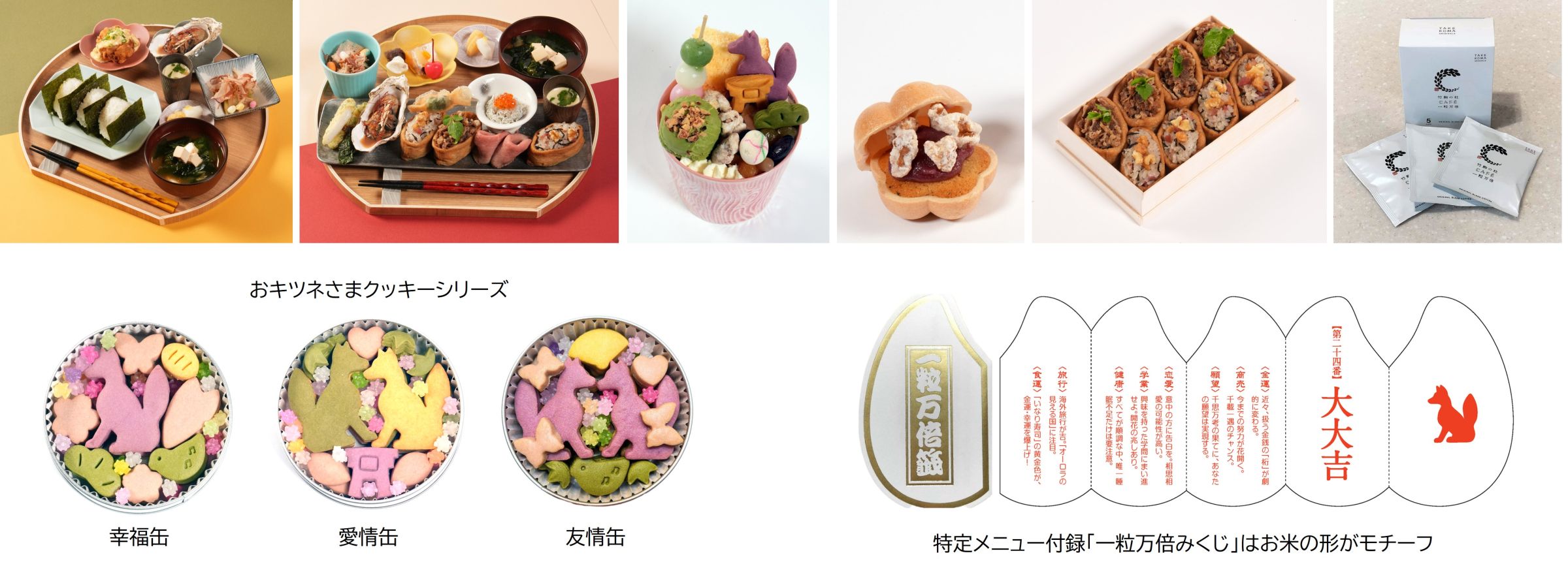
Top: Food menu, sweets menu, souvenirs Bottom: Souvenirs, special menu supplements
Regional collaboration through product sales and events
Products from Miyagi Prefecture will be on sale, including "Temari," a traditional craft that has been considered an "auspicious gift," "obico," an upcycled product of vintage kimonos and obi, and "Tennen Kaiki," an aroma and cosmetics brand that uses natural materials from Tohoku. Participatory events such as "Temari" workshops will also be held to promote interaction between the shrine and worshippers and to foster community building.

Video promotion with an eye on inbound tourism
The video was produced by the Sendai-based creative team MOREDRAW. The Cannes Film Festival-winning creators from Paris, France, capture on camera the development of local culture and community centered around Takekoma Shrine.
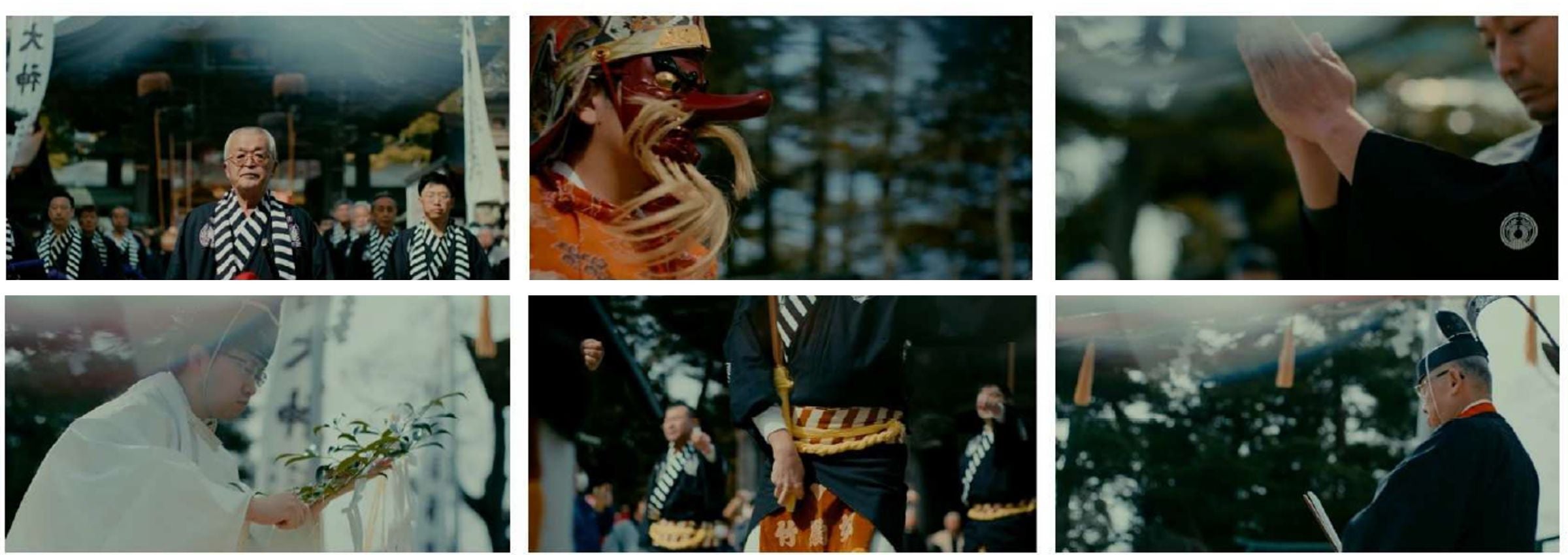
Key points of spatial concept design
The concept of the spatial concept design is "Awaken." Just as worshippers feel freed and healed by immersing themselves in the sacred atmosphere that permeates the shrine, we designed a space in the rest area that evokes the senses that tend to fade in everyday life. The "Tankoma Forest," a shrine forest that allows one to feel the four seasons, the architecture that blends with nature, and the interior that exudes the strength and warmth of nature stimulate the senses of visitors, including sight, touch, and smell, and aim to create a place that enriches the soul and creates interaction and excitement.
The landscaping, architecture, and interior are seamlessly connected to create a sense of oneness with nature. The approach side has a large opening and is entirely made of glass, so that visitors can spend time looking at the shrine forest and the Zuishinmon Gate from the rest area. Earth and wood from Tohoku are used for interiors materials, and by using the same materials for the exterior and interior spaces, the feeling of standing in the forest is maximized. We are also working on a sustainable concept design to create a space that will be loved by people for a long time.
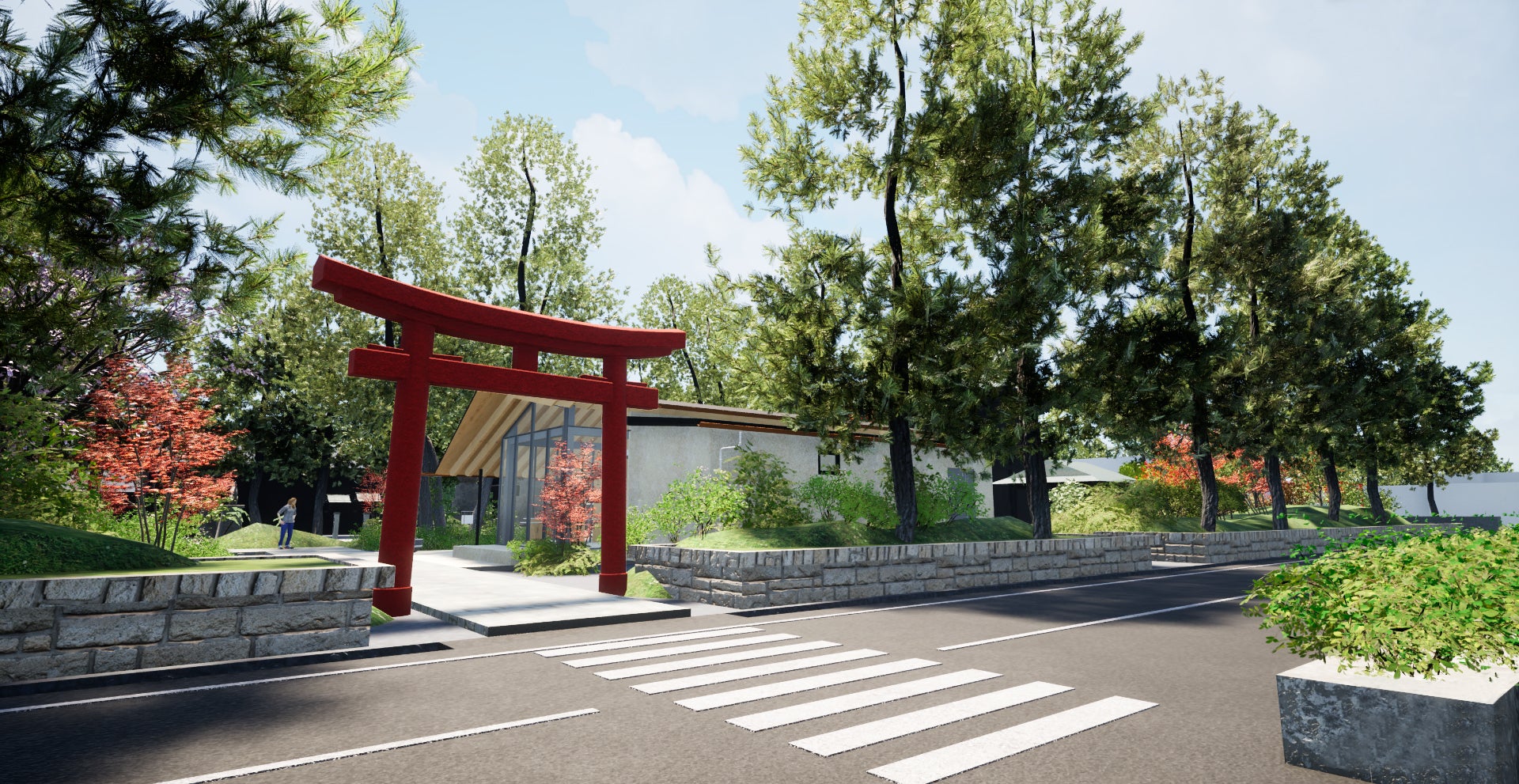
Landscaping | Maintenance of the Shrine Forest
Based on the theme of a natural forest that changes its appearance with the seasons, we made use of the existing pine and Himalayan cedar trees and combined evergreen and deciduous trees.

Architecture | Building and gable roof leading to Zuishinmon Gate
The building is located along the approach to the shrine. A wooden gabled roof connects the axis from the torii gate at the entrance to the shrine to the Zuishinmon Gate. The rafters are made from local red pines (trees that gods reside in) and wood from the Tohoku region, as there are many red pines on the site.
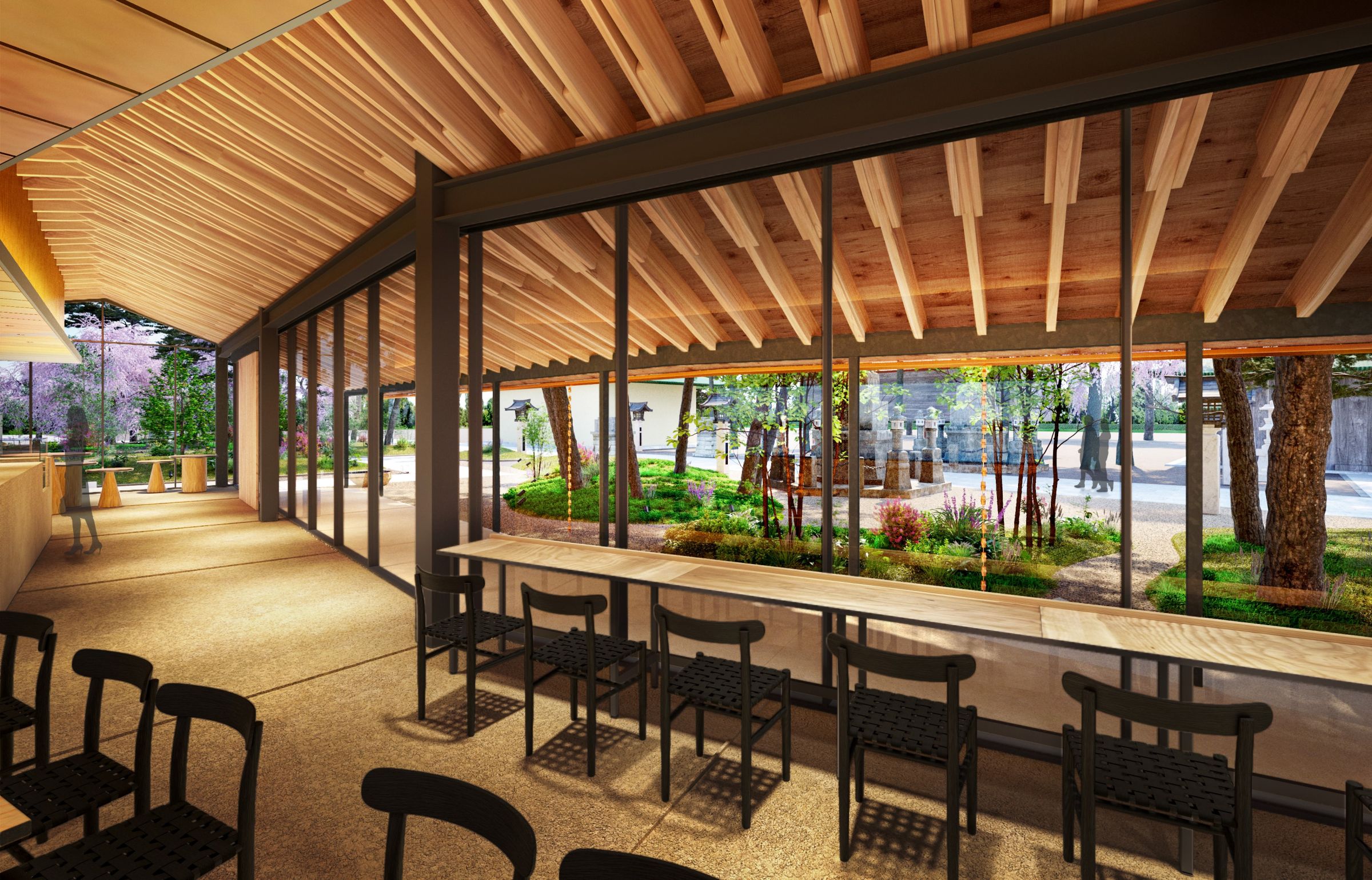
Interior | Creating a sense of unity with nature
The openings, natural interiors materials, gradient painted ceiling, and lighting plan bring out the rich forest's changing expressions with the seasons. As it is open to the approach to the shrine, it is easy for visitors to access the shrine.
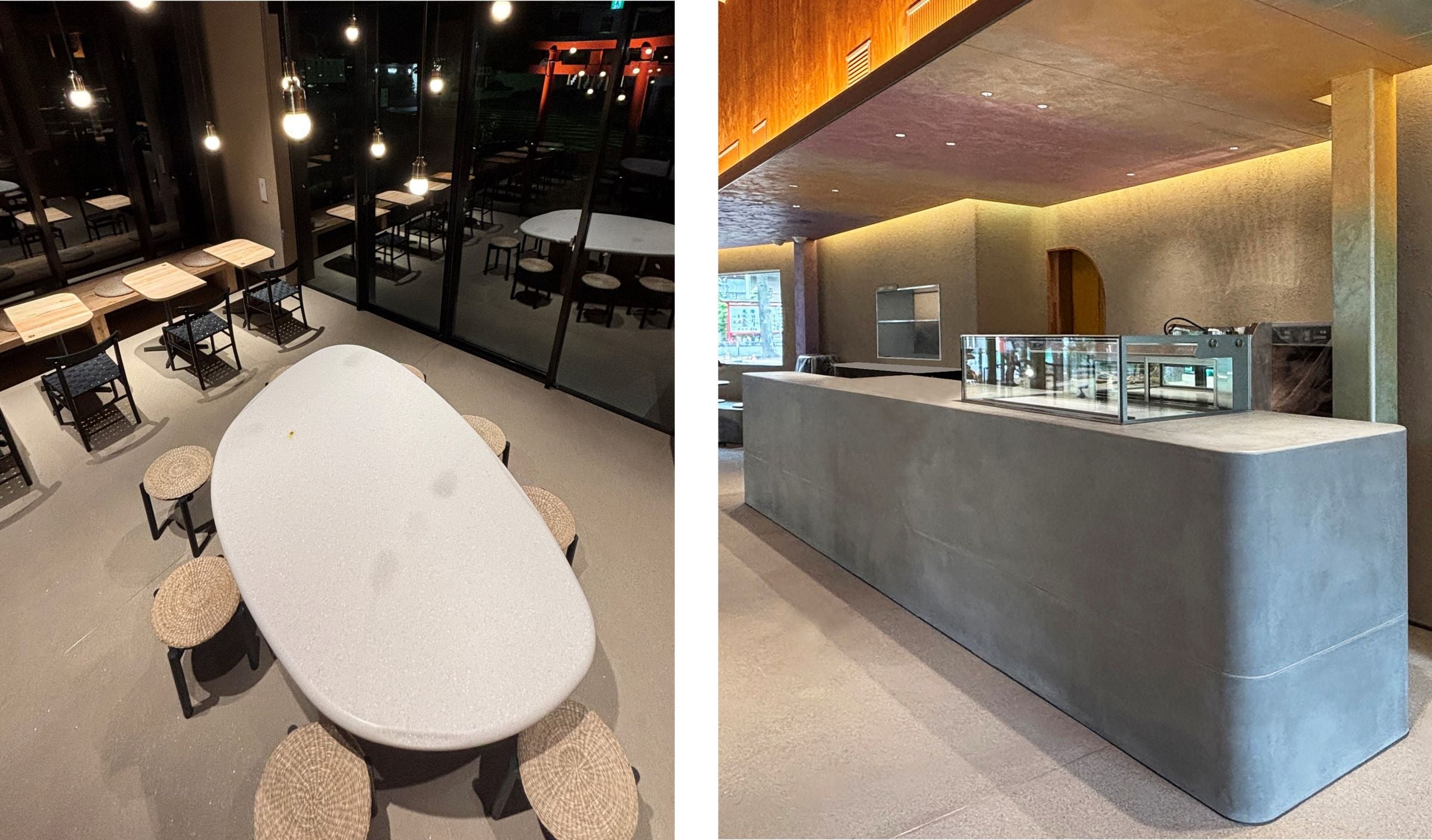
Interior | The brand's passion is reflected in the motif
The grain of the slogan "ichiribu manbai" (``one grain is worth ten thousand grains'') which is also in the facility's name is represented on the symbol table, while the ``millstone'' necessary for processing grains is represented as the motif of the main counter.
Amenities, logos, main visuals, etc.
Sustainable Initiatives
The timber was selected in cooperation with the forestry association of Tome City, Miyagi Prefecture, and local species were used. Oak wood, which is generally difficult to distribute, is also used for fixtures and other items, contributing to forest circulation. construction and processing were carried out in cooperation with Tohoku region companies, and consideration was given to the use of local resources and the reduction of environmental impact, such as reducing energy consumption and carbon dioxide during transportation.
Use of wood for fittings and fixtures
The entrance door is made of zelkova, the other doors are made of wild cherry, and the original furniture such as tables and chairs are made of cut Himalayan cedar and fir trees that were growing on the shrine grounds and were at risk of falling due to rotting. The interior space is filled with the atmosphere of a rich forest created by the diverse trees. *The recycled trees are branded with the Takekoma Shrine's name as a message.

Wood preparation and processing: Tome Town Forestry Association
Related information
| Shrine name | Takekoma Shrine, one of the three Inari shrines in Japan (1-1 Inaricho, Iwanuma City, Miyagi Prefecture) |
|---|---|
| Total site area | Shrine total site area: Approximately 41,000 m2 / Project plan area: Approximately 1,500 m2 (first phase only) |
| First phase opening details and area | "Takekoma no Mori CAFÉ Hitobumimanbai" (building area 187.46 m2), Takekoma no Mori (first phase development: approx. 1,500 m2) |
| Overview of "Takekoma no Mori CAFÉ Hitotsubu Manbai" | Business hours and holidays: 10:00-17:00 (may vary depending on the season) Open all year round (planned) Opening date: Thursday, December 26, 2024 from 12:00 p.m. |
| "Takekoma no Mori CAFÉ Hitobito Manbai" Official Website |
※please note
・The linked website is not a NOMURA Co.,Ltd. website and is not under our control.
・The address of the website posted in this notice is the one at the time of creation of this page. Website addresses are subject to obsolescence or change. Please check yourself for the latest address.
・Please check with the linked organization/organization regarding the linked website.
Please contact us using the button below if you have an inquiry, want to request a quote or request documents.
We have created a separate “FAQ page” that lists the most common questions we are asked.
Please take a look at this page if you have a question.